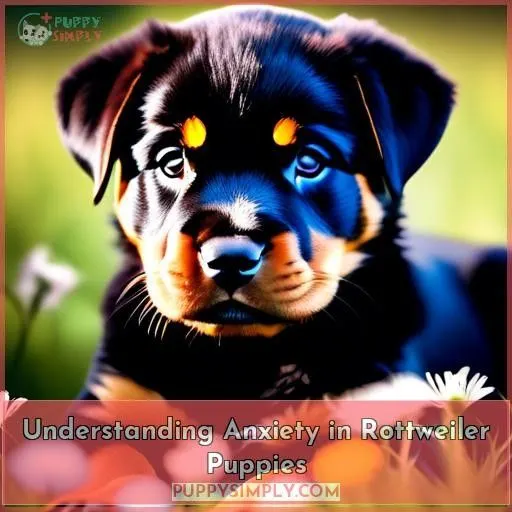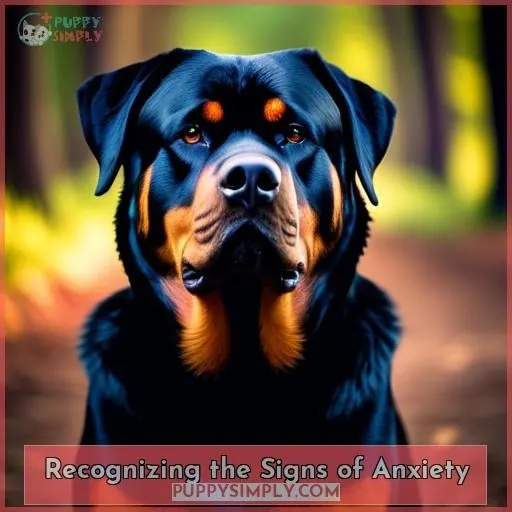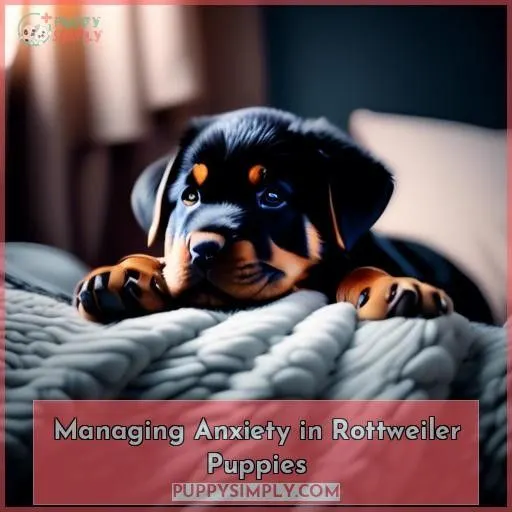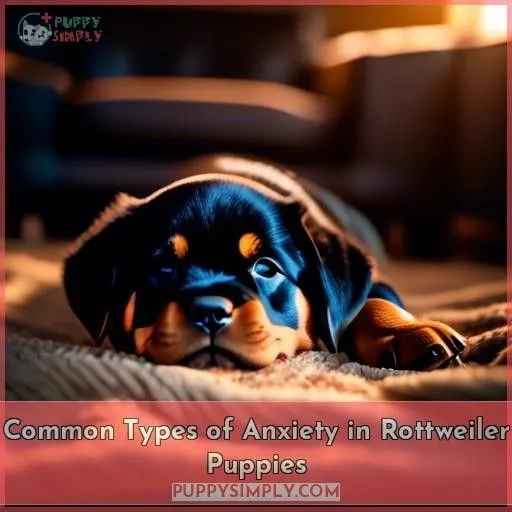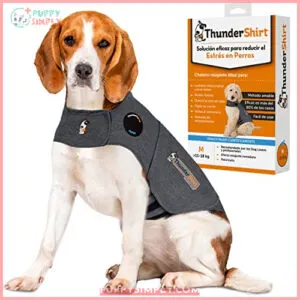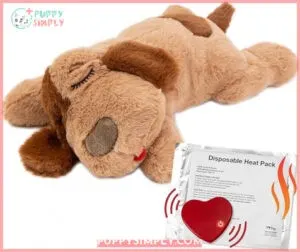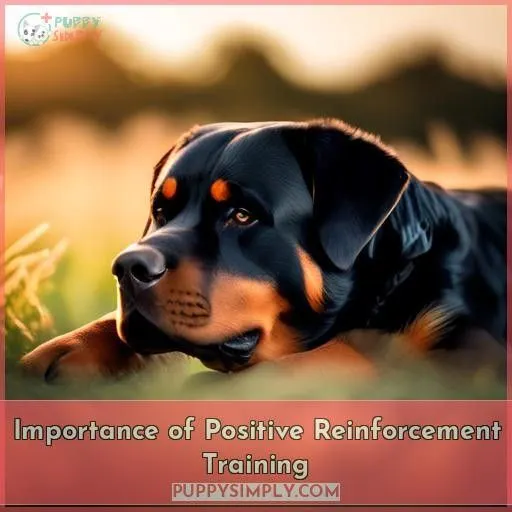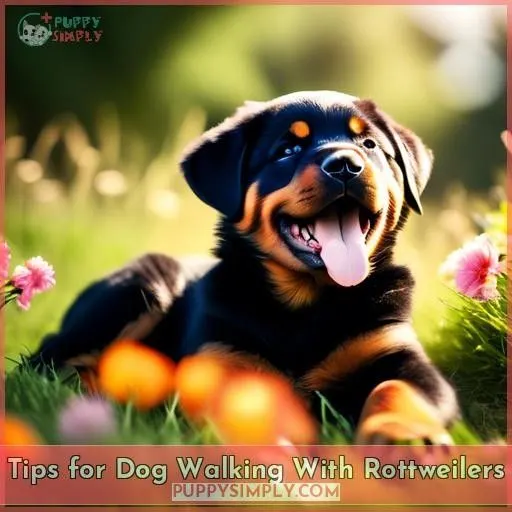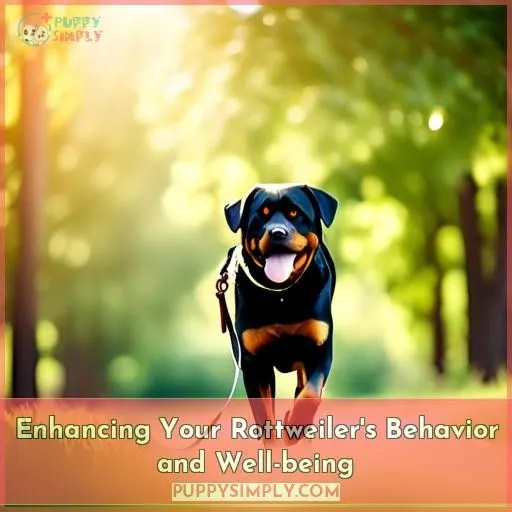This site is supported by our readers. We may earn a commission, at no cost to you, if you purchase through links.
 You can help calm your restless Rottweiler by creating a routine.
You can help calm your restless Rottweiler by creating a routine.
Using positive reinforcement training.
Providing plenty of exercise and mental stimulation.
Avoiding triggers like yelling or punishment.
Identify signs of anxiety like growling, pacing, or panting.
Remove stressors.
Calming aids like hemp chews, interactive toys, and pheromone diffusers can also soothe an anxious Rottie.
With patience and consistency, you’ll learn techniques for managing common anxieties like separation or sound fears in this high-energy breed.
By understanding your Rottweiler’s needs, you’ll build a stronger bond and a calmer companion.
Table Of Contents
- Key Takeaways
- How to Get Rottweilers to Calm Down?
- Understanding Anxiety in Rottweiler Puppies
- Identifying the Causes of Anxiety
- Recognizing the Signs of Anxiety
- Managing Anxiety in Rottweiler Puppies
- Common Types of Anxiety in Rottweiler Puppies
- Best Practices for Calming Your Rottweiler
- Importance of Positive Reinforcement Training
- Tips for Dog Walking With Rottweilers
- Enhancing Your Rottweiler’s Behavior and Well-being
- Frequently Asked Questions (FAQs)
- How can I identify the specific cause of my Rottweilers anxiety?
- What are some common signs of anxiety in Rottweilers?
- How can I manage my Rottweilers anxiety during walks?
- What are some effective training methods to help my Rottweiler overcome anxiety?
- How can I ensure my Rottweilers well-being while traveling?
- Conclusion
Key Takeaways
- Identify and remove triggers for anxiety in Rottweilers, such as lack of routine, yelling, confusing commands, staring directly, or unnecessary punishment.
- Use positive reinforcement training to encourage calm behavior and reward desired actions.
- Provide a safe and comfortable environment, such as a crate or designated room, and engage your dog in tasks and challenges to reduce anxiety.
- Consider using calming aids like hemp oil, desensitization techniques, and calming treats to help your Rottweiler cope with anxiety.
How to Get Rottweilers to Calm Down?
To calm down a Rottweiler, consider the following steps:
- Exercise: Make sure your Rottweiler gets sufficient daily exercise, including playtime and activities like fetch, laser pointer games, or obstacle courses.
- Anti-Anxiety Supplements: Try supplements containing L-Tryptophan, L-Theanine, or Melatonin to help manage anxiety.
- Training: Teach your Rottweiler to relax and stay calm by practicing behavior modification exercises, such as asking them to sit and stay in situations where they’re usually fearful or anxious.
- Socialization: Help your Rottweiler become more comfortable with different environments and people by exposing them to various situations and experiences.
- Redirect Attention: When your Rottweiler is in a situation where they’re usually anxious, redirect their attention to a task or activity to help them focus on something other than their anxiety.
Understanding Anxiety in Rottweiler Puppies
Rottweiler puppies can experience various forms of anxiety, including separation anxiety, sound anxiety, and travel anxiety. These anxieties can be triggered by a lack of routine, yelling, confusing commands, staring directly, or unnecessary punishment. To help your Rottweiler puppy overcome anxiety, it’s essential to identify the causes and signs of anxiety, manage the anxiety effectively, and provide positive reinforcement training for calmness.
Separation anxiety occurs when a Rottweiler puppy is left alone and feels distressed. Signs of separation anxiety include pacing, drooling, biting, or destructive behaviors. Sound anxiety is triggered by loud noises like thunder, fireworks, or a vacuum cleaner, while travel anxiety can be caused by fear of moving vehicles or intimidating places like vet visits or boarding kennels.
To help your Rottweiler puppy cope with anxiety, consider using hemp oil, which has been reported to be effective for approximately 67% of dog owners in reducing anxiety. Desensitization techniques, such as gradually exposing your dog to the trigger and immediately reversing it, can also be effective in helping your puppy become desensitized to the anxiety-causing stimuli.
In addition to these strategies, providing a safe and comfortable environment for your Rottweiler puppy, such as a crate or a designated room, can help alleviate anxiety. Giving your dog jobs and challenges, like obedience training or walks to new places, can also engage their mind and reduce anxiety.
Identifying the Causes of Anxiety
Is your Rottweiler pup feeling anxious? The culprit could be a lack of routine, yelling, or confusing commands. Avoid staring directly at your dog and unnecessary punishment – these can worsen their anxiety.
Lack of Routine
Lack of routine is a common cause of anxiety in Rottweiler puppies. They thrive on consistency and need to know when they wake up, when they go to bed, and when to expect their next meal or walk. If they don’t have a daily routine, this can lead to anxiety. To help your Rottweiler puppy overcome anxiety, establish a consistent routine and stick to it. Here are three key points to keep in mind:
- Consistency: Stick to a regular schedule for feeding, exercise, and playtime. This will help your puppy feel secure and reduce anxiety.
- Routine Training: Use positive reinforcement training to teach your puppy desired behaviors. This will help them understand what’s expected of them and reduce anxiety caused by confusion.
- Socialization: Make sure your puppy is exposed to a variety of environments, people, and other animals. This will help them become more confident and less anxious in new situations.
Yelling
Yelling at your Rottweiler puppy can be detrimental to their well-being. It can increase their anxiety levels and make them more rambunctious.
Instead, use positive reinforcement techniques to encourage calm behavior. Speak in a calm, gentle tone and use clear, concise commands. Reward your Rottweiler for following these commands to reinforce good habits.
This will create a calmer environment for both you and your dog.
Confusing Commands
Confusing commands muddle your Rottweiler’s understanding, leading to misbehavior instead of obedience. Clear, consistent cues are the bedrock of good behavior, even amidst travel anxiety’s chaos.
Staring Directly
When your Rottweiler puppy is gazing at you with a direct stare, it’s crucial to discern that this behavior can signal anxiety. The intense eye contact can be interpreted as a dominant posture, which may induce an aggressive reaction or fear in your puppy.
To assist your Rottweiler puppy in feeling more at ease and mitigating anxiety, refrain from staring directly at them for prolonged intervals. Instead, endeavor to maintain a tranquil and relaxed demeanor. This will aid your puppy in feeling more secure and less susceptible to displaying anxious behaviors.
Unnecessary Punishment
After staring, unfair treatment through harmful methods ramps up anxiety. These negative consequences can lead to emotional damage and behavioral problems, making a mountain out of a molehill.
Recognizing the Signs of Anxiety
If your Rottweiler is feeling anxious, you may notice signs like growling, barking, or whining. Pay attention to their body language too – a tucked tail, whale eye, or freezing could indicate heightened anxiety.
Growling
Understanding the growling of your Rottweiler is vital for maintaining a harmonious relationship with your canine companion. Growling can be an indicator of various emotions, ranging from joy to aggression. Here are three fundamental points to consider when deciphering your Rottweiler’s growling:
- Contented Growling: When your Rottweiler is cheerful or content, their growling tends to be gentler and accompanied by a wagging tail, relaxed posture, and a playful disposition.
- Resource Protection: Growling can also indicate resource guarding, where your dog is safeguarding something of value, such as food or toys. In such instances, it’s imperative to address the underlying cause and teach your dog to share resources.
- Aggressive Growling: If your Rottweiler is growling at you or others, it could be a sign of aggression. In this case, it’s essential to pinpoint the triggers and seek professional assistance from a dog behaviorist or trainer.
Barking or Whining
Barking or whining can be a sign of anxiety in your Rottweiler. Pay attention to bark volume, tone variation, whining duration, and pitch differences. Repetitive patterns may indicate stress.
Body Language
As a Rottweiler owner, it’s essential to comprehend your dog’s body language signals. Emotional stressors can trigger fear responses, so techniques for de-escalation are vital for managing anxiety. Observe your dog’s body language for indications such as tucked tail or whale eye, and respond with reassurance and positive reinforcement.
Freezing
When your Rottweiler puppy freezes, they’re shutting down from anxiety. This is a clear sign that something is upsetting them, and it’s important to pay attention to their body language. Freezing is a form of stillness that indicates a high level of unease. It’s a way for your dog to cope with stress or fear, often by relying on stillness to go undetected.
To manage your Rottweiler’s anxiety, it’s vital to identify the triggers and remove them. This might include changes in routine, yelling, confusing commands, staring directly at your dog, or punishment that validates their fear.
By understanding the signs of anxiety and addressing the root causes, you can help your Rottweiler puppy feel more comfortable and secure.
Pacing
Pacing is a common sign of anxiety in Rottweilers.
To help your dog, identify the cause of their anxiety, such as separation anxiety, sound phobia, or travel fear.
Modify their diet and exercise regimen to reduce stress.
Socialize them with new people and places.
Use positive reinforcement training for calmness.
If necessary, consider desensitization techniques or calming aids like hemp oil or compression wraps.
Managing Anxiety in Rottweiler Puppies
You can effectively manage your Rottweiler puppy’s anxiety by removing triggers that cause distress and avoiding forcibly confronting their fears. Instead, focus on positive reinforcement techniques, make sure to provide a balanced diet, provide ample exercise and mental stimulation, and gradually socialize them with new people, places, and experiences in a controlled and nurturing environment.
Remove Triggers
To manage anxiety in Rottweiler puppies, start by identifying and removing triggers. This involves environmental management, routine establishment, and behavior modification. Always use positive reinforcement training to encourage calmness. Here are five key steps:
- Trigger Identification: Recognize what causes anxiety in your puppy.
- Environmental Management: Adjust the puppy’s surroundings to minimize anxiety.
- Routine Establishment: Create a consistent daily schedule.
- Behavior Modification: Teach the puppy to cope with anxiety-inducing situations.
- Positive Reinforcement: Reward calm behavior to reinforce good habits.
Don’t Force Confrontation
Don’t force confrontation with your Rottweiler’s fears. Use positive reinforcement to calm your dog and manage anxiety. Remove triggers, socialize, and crate train for safety. Gradually expose your dog to triggers using desensitization techniques.
Positive Reinforcement
Positive reinforcement is a vital aspect of managing anxiety in your Rottweiler. By utilizing a reward system, you can incentivize desired behaviors and alter undesirable ones. Consistency in training is paramount, so refrain from punishment and prioritize positive interactions. This approach fosters a more robust connection between you and your dog, promoting tranquility and compliance.
Diet, Exercise, and Mental Stimulation
Managing anxiety in Rottweiler puppies involves more than just positive reinforcement. A balanced diet, regular exercise, and mental stimulation play a vital role in keeping your pup calm and relaxed. Here’s how:
- Diet: A balanced diet can help regulate your dog’s mood and energy levels. Avoid feeding your Rottweiler high-fat or highly processed foods.
- Exercise: Regular exercise is essential for physical and mental well-being. Daily walks and playtime can help your Rottweiler puppy release pent-up energy and reduce anxiety.
- Mental Stimulation: Engage your Rottweiler in interactive toys, puzzles, or training sessions to keep their mind sharp and reduce stress.
Socialize With New People/Places/Things
After bolstering your Rottweiler’s well-being with diet and exercise, it’s vital to focus on socialization during puppyhood for their development and confidence.
| Importance | Exposure |
|---|---|
| Builds Confidence | New Environments |
| Prevents Anxiety | Diverse Animals |
| Enhances Training | Varied People |
| Fosters Control | Novel Situations |
Common Types of Anxiety in Rottweiler Puppies
You’re not unfamiliar with the difficulties of rearing a Rottweiler pup, especially concerning anxiety.
Three typical forms of anxiety that can affect these pups are:
Separation anxiety, where they fear being away from their owners.
Sound anxiety, triggered by loud noises like fireworks or thunderstorms.
Travel anxiety, caused by unfamiliar environments or modes of transportation.
Identifying and understanding the specific type of anxiety your pup is experiencing is essential for developing an effective management plan.
Separation Anxiety
Separation anxiety is a common type of anxiety in Rottweiler puppies.
It’s often triggered by changes in routine, yelling, confusing commands, staring, or punishment.
To manage this anxiety, it’s essential to eliminate triggers, avoid forcing confrontation, and use positive reinforcement training.
Additionally, maintaining a healthy diet, exercise, and mental stimulation can help.
Socialize your puppy with new people, places, and things to reduce anxiety.
Sound Anxiety
Sound anxiety in Rottweilers is a common concern, with fear of thunderstorms being a common noise trigger. Desensitization training and CBD oil benefits can help manage this type of anxiety. Sound therapy and positive reinforcement training are also effective techniques.
Travel Anxiety
Travel anxiety in Rottweilers can be managed with the right strategies.
Start by acclimating your dog to the car with short trips.
Use positive reinforcement for calm behavior and avoid forcing confrontation with fears.
Consider travel management techniques like crate training or baby gates for safe spaces.
For coping mechanisms, try calming treats or compression wraps like Thundershirts.
Best Practices for Calming Your Rottweiler
To effectively soothe an anxious Rottweiler, consider using calming aids like hemp mobility chews, interactive chew toys, compression wraps like the Thundershirt, or pheromone diffusers. You can also try heartbeat-simulating plush toys to provide comfort and security for your furry companion.
Hemp Calming Mobility Chews for Dogs
If your Rottweiler is anxious, you’re not alone. Many dog owners face the same challenge. But there’s a solution that can help your furry friend feel more tranquil and relaxed: hemp calming mobility chews. These chews are specially formulated to promote calmness and joint mobility in dogs, making them an excellent choice for Rottweilers prone to anxiety.
These chews aren’t only effective but also third-party tested and Clean Label Project approved, ensuring purity and safety. They come in a convenient size that’s easy to administer, making them perfect for dogs that get anxious during fireworks holidays or storms. And the best part? They can help calm your dog down swiftly.
However, it’s critical to remember that not all dogs respond the same way to hemp calming mobility chews. Some may not like the flavor, and it may take longer than expected to see results. Additionally, they may not be effective for dogs with severe anxiety. But for many Rottweilers, these chews can make a significant difference in their overall well-being.
Best For: Rottweilers prone to anxiety and those experiencing joint discomfort
- Helps promote calmness and joint mobility
- Third-party tested and Clean Label Project approved
- Easy to feed and can calm dogs down quickly
- Some dogs may not like the taste
- May take longer than expected to see results
- May not be effective for dogs with severe anxiety
Nylabone Chew Treat Interactive Dog Toy

When your Rottweiler’s energy surges like an untamed wave, the Nylabone Chew Treat Interactive Dog Toy can provide solace.
Envision this: a durable toy, infused with bacon aroma and prepared to be filled with treats, which not merely occupies your pup’s jaws but also aids in the cleansing of their teeth.
It’s akin to addressing two concerns simultaneously—your furry companion’s anxiety is alleviated, and their dental well-being is enhanced.
Bear in mind that while it’s intended for canines weighing up to 35 pounds, certain Rottweilers may transform it into a chewed-up enigma, necessitating supervision during their playtime.
Best For: Rottweilers weighing up to 35 pounds
- Satisfies dogs’ natural urge to chew
- Helps reduce plaque and tartar buildup
- Durable and long-lasting
- Some dogs may be able to damage the toy
- Treats can be difficult to insert
- Can be messy with crumbs
Thundershirt Dog Anxiety Treatment Gray Medium
Regarding calming your Rottweiler, the Thundershirt Dog Anxiety Treatment Gray Medium is a game-changer. This innovative product applies gentle pressure to your dog, mimicking the comforting embrace of a human hug. By wearing the Thundershirt, your Rottweiler can feel more secure and relaxed, especially during stressful situations like thunderstorms or separation anxiety.
The Thundershirt is easy to use and adjust, making it a convenient solution for pet owners who want to help their furry friends feel more at ease. Plus, it’s machine washable, ensuring that it stays clean and fresh for your dog’s comfort.
With an impressive success rate of over 80%, the Thundershirt is a trusted choice among pet owners looking for a simple yet effective way to calm their anxious Rottweilers. So, if your dog is struggling with anxiety, consider giving the Thundershirt a try. It might just be the key to helping your Rottweiler feel more calm and confident.
Best For: Rottweilers experiencing anxiety, fear, or over-excitement.
- Over 80% success rate
- Calms anxiety and stress
- Easy to use and adjust
- May not be effective for all dogs
- May take some time to adjust to wearing
- Not suitable for dogs with respiratory or joint issues
Calming Chews for Dog Anxiety

Calming chews for dogs are a popular solution for managing anxiety in pets. These treats contain natural ingredients that have a calming effect without sedating the dog. Look for chews with proven active ingredients like L-theanine, melatonin, and chamomile, as well as all-natural inactive ingredients. Some brands, like Native Pet and Reggie, offer calming chews that can help dogs cope with stressful situations and reduce anxiety.
To choose the best calming chews for your Rottweiler, consider the following factors:
- Ingredients: Look for chews that contain natural, scientifically proven ingredients, such as L-theanine, melatonin, and chamomile. These ingredients have been shown to promote relaxation and inhibit anxious responses in dogs.
- Dosage: Follow the recommended dosage on the product label, which may vary depending on the dog’s weight. For example, Reggie’s Anytime Calming Chews suggest different dosages for dogs under 25 lbs, 25-75 lbs, and over 75 lbs.
- Frequency: Calming chews can be given daily for general anxiety relief or as needed for situational anxiety, such as during thunderstorms or fireworks.
- Consistency: Some dogs may require a consistent use of calming chews for several weeks to see the full benefits.
- Combinations: Calming chews can be used in conjunction with other anxiety management tools, such as Thundershirts, puzzle toys, and behavioral training sessions.
Remember to consult your veterinarian before starting your Rottweiler on any new supplement, including calming chews. They can provide guidance on the appropriate dosage and help you find a product that suits your dog’s specific needs.
Best For: Dogs with anxiety, restlessness, separation anxiety, insomnia, and phobias
- Eases anxiety and promotes better sleep
- Contains a blend of proven calming ingredients like melatonin and chamomile
- Allergy-friendly and made in the USA
- May not be suitable for dogs with limited teeth
- Smell may be off-putting to some dogs
- May take several weeks to see full benefits
Thunderease Dog Calming Pheromone Diffuser

To help your Rottweiler overcome anxiety, consider using the Thunderease Dog Calming Pheromone Diffuser. This device releases a calming scent that mimics the natural pheromones of a mother dog, providing a sense of security and comfort to your pup. By following these steps, you can effectively use the Thunderease Dog Calming Pheromone Diffuser:
- Plug in the diffuser in a room where your Rottweiler spends most of its time.
- Allow the diffuser to run continuously for at least 30 days to help your dog become accustomed to the calming pheromones.
- Gradually introduce the diffuser to your dog, allowing it to get used to the new scent.
- Monitor your dog’s behavior and adjust the placement of the diffuser if necessary.
Best For: Rottweilers experiencing anxiety, such as fear of loud noises, separation anxiety, problem barking, and destructive chewing.
- Releases calming pheromones that mimic a mother dog’s natural scent, providing a sense of security and comfort.
- Over 90% effective in reducing anxiety and unwanted behavior.
- Drug-free solution that is safe for dogs of all ages.
- May take up to 2 weeks to start working.
- Requires continuous use for at least 30 days to be effective.
- May not be suitable for all dogs.
Heartbeat Puppy Comfort Cuddler Pillow
Imagine your Rottweiler, a bundle of energy and curiosity, always on the go.
But what if they’re not just restless, but anxious?
The Heartbeat Puppy Comfort Cuddler Pillow is designed to help your furry friend find peace in their chaotic world.
This interactive toy recreates maternal intimacy for puppies, appealing to their natural instincts as pack animals.
It aids in crate training and separation anxiety, providing calming aid for anxious dogs.
The pillow includes a battery-operated heartbeat unit and non-toxic disposable warmer pack, making it a perfect companion for your Rottweiler.
Best For: Rottweilers and anxious dogs seeking comfort and tranquility.
- Appeals to natural pack instincts, reducing negative behaviors.
- Aids in crate training and separation anxiety.
- Provides calming aid through heartbeat simulation and warmth.
- Requires a special screwdriver for battery compartment access.
- Heartbeat cannot be turned off, potentially wasting battery life.
- Velcro opening may pull apart after extended use.
Importance of Positive Reinforcement Training
You’ll want to focus on teaching your Rottweiler desired behaviors and avoiding rewarding misbehavior with attention. Positive reinforcement training encourages good habits by reinforcing actions you want to see with treats, praise, or other rewards.
Teaching Desired Behaviors
Positive reinforcement is the key to teaching your Rottweiler desired behaviors. By rewarding good behavior and ignoring misbehavior, you encourage your dog to repeat the good behavior and discourage the misbehavior. This approach validates your dog’s good choices and helps them understand what’s expected of them.
Avoiding Misbehavior Attention
To avoid misbehavior attention, focus on positive reinforcement training. Pet your Rottweiler only when they exhibit desired behaviors. This teaches them that good behavior earns attention, not misbehavior. By reinforcing positive actions, you encourage your dog to repeat them.
Encouraging Good Habits
Fostering good habits in your Rottweiler is paramount for their well-being. Reward your dog for desired behaviors, ensuring consistency in training. Avoid giving negative attention for misbehaviors, as this can reinforce unwanted actions. Instead, offer calm and rewarding interactions, reinforcing positive behaviors through patience and positive reinforcement.
Tips for Dog Walking With Rottweilers
You can help your Rottweiler stay calm during walks by implementing leash training techniques that teach them to walk beside you without pulling.
Preparing your dog with calming exercises before walks, like rewarding seated stays, can also prevent over-excitement.
In-home training sessions reinforce desired behaviors.
Doggie daycare provides professional guidance and socialization opportunities to improve your Rottweiler’s obedience on walks.
Leash Training
Leash training is essential for Rottweilers, particularly powerful breeds susceptible to leash pulling. Loose leash walking and heeling are prevalent objectives. Positive reinforcement methods, including rewarding desired behaviors, can prove beneficial. In-home dog training and daycare training alternatives are available for support.
Calming Dogs Before Walks
Before starting a walk, soothe your Rottweiler with deliberate petting. Utilize passive training during these instances, solidifying preferred behaviors. Consistent brief dog training intervals can enhance habits, making walks more pleasurable for both dog and human. Adhere to a plan for accomplishment, emphasizing positive reinforcement for compliance.
In-Home Dog Training
In-home dog training is an indispensable part of puppy development. It helps establish behavioral patterns and teaches effective techniques using training tools. Here are three tips for in-home dog training:
- Positive Reinforcement: Reward desired behaviors with treats, praise, or playtime.
- Consistency: Maintain a routine and be consistent with commands.
- Training Tools: Use leashes, clickers, and treats to guide training.
In-home training is a fundamental step in your puppy’s journey to becoming a well-behaved companion.
Daycare Training
Daycare training is an excellent option for Rottweilers that need more socialization and enrichment. Look for daycare facilities that prioritize positive reinforcement training and have professional staff. This can help your Rottweiler learn to enjoy walks and improve their behavior during outings.
Enhancing Your Rottweiler’s Behavior and Well-being
You can enhance your Rottweiler’s behavior and well-being by seeking guidance from dog behavior experts. They’ll recommend positive training techniques, like in-home dog training or daycare options, that reinforce obedience through positive reinforcement, fostering a well-behaved and confident companion.
Positive Training Techniques
Embrace positive reinforcement; it’s the golden ticket to your Rottweiler’s heart. Through passive training and recognizing anxiety cues, leash training becomes a walk in the park, turning attention validation into a breeze.
Dog Behavior Experts
Dog behavior experts offer valuable insights into enhancing your Rottweiler’s behavior and well-being. By understanding the importance of positive reinforcement training, you can teach your dog to do desired behaviors for recognition, avoiding misbehavior attention. Here are five ways to improve your dog’s behavior:
- Consistent Commands: Use a firm and clear tone when giving commands to your Rottweiler.
- Human Attention: Make sure your dog receives positive attention for good behavior.
- Behavior Training: Invest in professional behavior training to address specific issues.
- Leash Obedience: Teach your dog to walk next to you on a loose leash.
- Socialization: Expose your Rottweiler to new people, places, and things to promote good habits.
In-Home Dog Training and Daycare Options
In-home dog training and daycare options offer breed-specific training for your Rottweiler, ensuring positive reinforcement techniques are used. Professional assistance helps to address anxiety, while daycare options provide socialization and mental stimulation. Both methods enhance your Rottweiler’s behavior and well-being.
Positive Reinforcement for Obedience
Positive reinforcement transforms training into a game of fetch for your Rottweiler, rewarding every catch with treats and praise.
- Treats as training rewards
- Understanding behavior cues
- Mastering obedience commands
This method cultivates desired habits, ensuring your furry companion not only comprehends but also anticipates your next command. It’s akin to sharing a secret code with your dog, where every gesture strengthens a bond of understanding and respect.
Frequently Asked Questions (FAQs)
How can I identify the specific cause of my Rottweilers anxiety?
Just like a detective, you’ll need to observe your Rottie’s behavior closely. Note triggers, body language, and situations that seem to precede anxious reactions – this will help identify the root cause and develop a targeted plan to address it.
What are some common signs of anxiety in Rottweilers?
You’ll notice anxiety in your Rotti through growling, barking, pacing, tucking their tail, avoiding triggers, or destructive behaviors. Keep an eye out for these telltale signs, and address the root cause through positive reinforcement training.
How can I manage my Rottweilers anxiety during walks?
You can try desensitizing your Rottie to walk triggers gradually. Avoid forcing them into scary situations. Use treats and positive reinforcement to build their confidence. A calming aid like hemp chews can also help reduce anxiety during walks.
What are some effective training methods to help my Rottweiler overcome anxiety?
You can use positive reinforcement training, desensitization, and calming aids like compression wraps or hemp treats. Consistency and patience are key when managing anxiety in powerful breeds like Rottweilers.
How can I ensure my Rottweilers well-being while traveling?
Safeguard your Rottweiler’s serenity on the road – with calming compression wraps and soothing sounds, you’ll cruise through travels without a hitch. Prep your pup for a stress-free, enjoyable journey.
Conclusion
Consistent, constructive care and thorough commitment to calming a restless Rottweiler can cultivate a content canine companion. By comprehending and addressing the underlying causes of anxiety, you’ll reveal the key to tranquility for your Rottie. Prudent positive reinforcement, purposeful playtime, and patient practice will help you tame your pal’s troubling tendencies and transform them into a beautifully behaved, how-to-calm-down Rottweiler.

